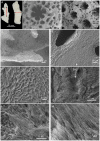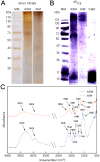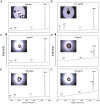The skeleton of the staghorn coral Acropora millepora: molecular and structural characterization
- PMID: 24893046
- PMCID: PMC4043741
- DOI: 10.1371/journal.pone.0097454
The skeleton of the staghorn coral Acropora millepora: molecular and structural characterization
Abstract
The scleractinian coral Acropora millepora is one of the most studied species from the Great Barrier Reef. This species has been used to understand evolutionary, immune and developmental processes in cnidarians. It has also been subject of several ecological studies in order to elucidate reef responses to environmental changes such as temperature rise and ocean acidification (OA). In these contexts, several nucleic acid resources were made available. When combined to a recent proteomic analysis of the coral skeletal organic matrix (SOM), they enabled the identification of several skeletal matrix proteins, making A. millepora into an emerging model for biomineralization studies. Here we describe the skeletal microstructure of A. millepora skeleton, together with a functional and biochemical characterization of its occluded SOM that focuses on the protein and saccharidic moieties. The skeletal matrix proteins show a large range of isoelectric points, compositional patterns and signatures. Besides secreted proteins, there are a significant number of proteins with membrane attachment sites such as transmembrane domains and GPI anchors as well as proteins with integrin binding sites. These features show that the skeletal proteins must have strong adhesion properties in order to function in the calcifying space. Moreover this data suggest a molecular connection between the calcifying epithelium and the skeletal tissue during biocalcification. In terms of sugar moieties, the enrichment of the SOM in arabinose is striking, and the monosaccharide composition exhibits the same signature as that of mucus of acroporid corals. Finally, we observe that the interaction of the acetic acid soluble SOM on the morphology of in vitro grown CaCO3 crystals is very pronounced when compared with the calcifying matrices of some mollusks. In light of these results, we wish to commend Acropora millepora as a model for biocalcification studies in scleractinians, from molecular and structural viewpoints.
Conflict of interest statement
Figures





Similar articles
-
The skeletal proteome of the coral Acropora millepora: the evolution of calcification by co-option and domain shuffling.Mol Biol Evol. 2013 Sep;30(9):2099-112. doi: 10.1093/molbev/mst109. Epub 2013 Jun 12. Mol Biol Evol. 2013. PMID: 23765379 Free PMC article.
-
Biochemical characterization of the skeletal matrix of the massive coral, Porites australiensis - The saccharide moieties and their localization.J Struct Biol. 2018 Sep;203(3):219-229. doi: 10.1016/j.jsb.2018.05.011. Epub 2018 May 30. J Struct Biol. 2018. PMID: 29859330
-
Soluble organic matrices of aragonitic skeletons of Merulinidae (Cnidaria, Anthozoa).Comp Biochem Physiol B Biochem Mol Biol. 2008 May;150(1):10-22. doi: 10.1016/j.cbpb.2008.01.002. Epub 2008 Jan 19. Comp Biochem Physiol B Biochem Mol Biol. 2008. PMID: 18325807
-
Coral biomineralization: A focus on intra-skeletal organic matrix and calcification.Semin Cell Dev Biol. 2015 Oct;46:17-26. doi: 10.1016/j.semcdb.2015.09.005. Epub 2015 Sep 5. Semin Cell Dev Biol. 2015. PMID: 26344100 Review.
-
Biology and ecology of the hydrocoral millepora on coral reefs.Adv Mar Biol. 2006;50:1-55. doi: 10.1016/S0065-2881(05)50001-4. Adv Mar Biol. 2006. PMID: 16782450 Review.
Cited by
-
Novel Genes, Ancient Genes, and Gene Co-Option Contributed to the Genetic Basis of the Radula, a Molluscan Innovation.Mol Biol Evol. 2018 Jul 1;35(7):1638-1652. doi: 10.1093/molbev/msy052. Mol Biol Evol. 2018. PMID: 29672732 Free PMC article.
-
Elevated CO2 delays the early development of scleractinian coral Acropora gemmifera.Sci Rep. 2018 Feb 12;8(1):2787. doi: 10.1038/s41598-018-21267-3. Sci Rep. 2018. PMID: 29434364 Free PMC article.
-
A comparison of two common sample preparation techniques for lipid and fatty acid analysis in three different coral morphotypes reveals quantitative and qualitative differences.PeerJ. 2017 Aug 2;5:e3645. doi: 10.7717/peerj.3645. eCollection 2017. PeerJ. 2017. PMID: 28785524 Free PMC article.
-
Coral Carbonic Anhydrases: Regulation by Ocean Acidification.Mar Drugs. 2016 Jun 3;14(6):109. doi: 10.3390/md14060109. Mar Drugs. 2016. PMID: 27271641 Free PMC article.
-
Gene expression associated with disease resistance and long-term growth in a reef-building coral.R Soc Open Sci. 2021 Apr 21;8(4):210113. doi: 10.1098/rsos.210113. R Soc Open Sci. 2021. PMID: 33996131 Free PMC article.
References
-
- Constantz B, Weiner S (1988) Acidic macromolecules associated with the mineral phase of scleractinian coral skeletons. J Exp Zool 248: : 253–258. Available: http://doi.wiley.com/10.1002/jez.1402480302. Accessed: 28 May 2013. - DOI
-
- Goffredo S, Vergni P, Reggi M, Caroselli E, Sparla F, et al.. (2011) The skeletal organic matrix from Mediterranean coral Balanophyllia europaea influences calcium carbonate precipitation. PLoS One 6: : e22338. Available: http://www.pubmedcentral.nih.gov/articlerender.fcgi?artid=3142144&tool=p.... Accessed: 1 Apr 2012. - PMC - PubMed
-
- Ramos-Silva P, Kaandorp J, Huisman L, Marie B, Zanella-Cleon I, et al.. (2013) The skeletal proteome of the coral Acropora millepora: the evolution of calcification by cooption and domain shuffling. Mol Biol Evol. Available: http://mbe.oxfordjournals.org/cgi/doi/10.1093/molbev/mst109. Accessed: 18 Jun 2013. - DOI - PMC - PubMed
-
- Cohen AL, Mcconnaughey TA (2003) Geochemical Perspectives on Coral Mineralization. In: Rosso JJ, editor. Reviews in Mineralogy & Geochemistry. Mineralogical Society of America, Vol. 54 . pp. 151–188.
-
- Allemand D, Ferrier-Pagès C, Furla P, Houlbrèque F, Puverel S, et al.. (2004) Biomineralisation in reef-building corals: from molecular mechanisms to environmental control. Comptes Rendus Palevol 3: : 453–467. Available: http://linkinghub.elsevier.com/retrieve/pii/S1631068304001368. Accessed: 27 Feb 2014.
Publication types
MeSH terms
Substances
LinkOut - more resources
Full Text Sources
Other Literature Sources

